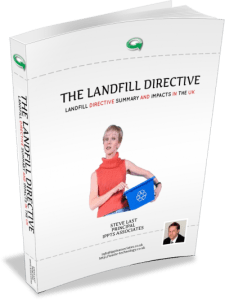Download our EU Landfill Directive pdf: A Brief Summary of the Requirements and Impacts
 Download our Landfill Directive pdf to find out how the EU Landfill Directive has been implemented for over 20 years in the 27 EU states.
Download our Landfill Directive pdf to find out how the EU Landfill Directive has been implemented for over 20 years in the 27 EU states.
Back in 2013, we thought that it would be helpful for our readers to create a report summary of the Landfill Directive, and you can still download this helpful pdf today.
It provides the main requirements of the directive and the impacts it had during its early implementation.
We also decided to provide our Landfill Directive pdf, as a free download. In return, all we ask is that you give us a Facebook “Like” or comment.
Our Landfill Directive Summary eBook covers the following subjects:
Landfill Directive pdf – Table of Contents
Landfill Directive Summary and Impacts in the UK
1. Introduction
2. Landfill Directive Implementation Timetable in the UK.
3. Landfill Directive Summary
4. Implementation of changes to the general types of waste accepted at UK landfill sites in the future
5. Changes in the interpretation of waste definitions compared to previous UK practice
6. Implementation of changes to the types of landfill site
7. Technical and planning requirements of the Landfill Directive summarized
8. Landfill Directive Impacts
9. The impacts of the Landfill Directive
10. Landfill Directive Summary of the Reclassification of Sites
11. The Effect of the Banning of Wastes and Pre-treatment Requirements within the Landfill Directive
12. Technical and Operational Requirements as Part of a Landfill Directive Summary
13. Summary of the Implications of the Landfill Directive to UK Industry
Your Landfill Directive pdf download is available below:
Landfill Directive pdf Update 20+ Years on
Overview
 Welcome to our comprehensive Landfill Directive pdf update on the Landfill Directive as it has proved to be. A pivotal piece of legislation that has reshaped waste management practices across the European Union and the United Kingdom.
Welcome to our comprehensive Landfill Directive pdf update on the Landfill Directive as it has proved to be. A pivotal piece of legislation that has reshaped waste management practices across the European Union and the United Kingdom.
This section of our Landfill Directive pdf article update aims to:
- demystify the Directive's contents,
- outline its objectives, and
- discuss its profound impacts on environmental policy, waste management strategies, and waste management industry compliance within the UK.
Objectives of the Landfill Directive
In 1999, the European Union introduced the Landfill Directive, which still aims to progressively lessen the negative effects of landfilling waste, and it has been the main EU directive providing all EU nations with the top-level requirements for landfilling ever since.
Despite the UK's decision to leave the EU on January 31, 2020, the UK continues to apply the requirements of the directive.
Its primary objectives include:
- Minimizing the amount of waste sent to landfills
- Encouraging the adoption of alternative waste management practices, such as recycling and recovery
- Establishing stringent operational standards for landfill sites to protect human health and the environment
- Promoting the sustainable use of natural resources through waste hierarchy principles
Key Components of the Directive
The directive is structured around several key components that collectively aim to reduce the environmental impact of landfills. These include:
- Waste Acceptance Criteria: Detailed guidelines on the types of waste that can be accepted at different classes of landfills.
- Technical Requirements: Standards for the design, operation, and closure of landfill sites, ensuring the minimization of leachate and gas emissions.
- Permits and Inspections: A comprehensive permitting process for landfill operators, including regular inspections and monitoring to ensure compliance.
Impact on the UK
The implementation of the Landfill Directive in the UK has led to significant changes in waste management practices, with notable impacts such as:
| Impact Area | Description |
|---|---|
| Environmental Protection | Enhanced measures to prevent pollution and protect land and water resources. |
| Waste Management Practices | Shift towards more sustainable practices, with an increased focus on recycling and waste recovery. |
| Regulatory Compliance | New obligations for landfill operators, leading to improved operational standards and monitoring. |
| Economic Implications | Investments in alternative waste management technologies and practices, creating new opportunities and challenges for the industry. |
As explained in our Landfill Directive pdf: The Landfill Directive's Revolutionary Approach to Hazardous Waste Disposal in the UK
Introduction
Our Landfill Directive pdf recognizes that the directive was a landmark move that revolutionized waste management practices in the UK. It marked a significant turning point for the United Kingdom.
For the first time, landfills were categorized into three distinct types:
- hazardous,
- non-hazardous, and
- inert.
This classification system brought an end to the UK's long-standing practice of co-disposing hazardous waste with non-hazardous waste, a method that:
- got rid of the chemical dangers by putting all the reactive substances into the Municipal Solid Waste (MSW), which was where the dangerous waste liquids went. Everything in the hazardous waste that was reactive and posed big health and environmental risks was neutralized, as long as only a small proportion of hazardous waste (less than 15%) was added to the MSW.
- and replaced it by simply burying it in the hope that the dangerous materials would never leak out.
Additionally, the categorization recognized inert waste as a separately licensed category, further refining the waste management framework. This short article explores the implications of these changes and their impact on the UK's approach to landfill management.
Understanding the Categories
The Landfill Directive's categorization of landfills into three types aimed to address specific environmental and health concerns associated with different waste materials. Here's a brief overview of each category:
- Hazardous Landfills: Sites designated for waste that poses a considerable threat to the environment or human health, requiring stringent controls and management practices.
- Non-Hazardous Landfills: Facilities for waste that, while not posing an immediate toxic threat, still requires careful management to prevent pollution and harm.
- Inert Landfills: Sites for waste that does not undergo any significant physical, chemical, or biological transformations, thus posing minimal risk to the environment.
Landfill Directive pdf – Marks the End of Co-Disposal Practices
Before the implementation of the Landfill Directive, the UK practiced co-disposal, where hazardous and non-hazardous wastes were mixed and disposed of in the same landfill sites. The dangers were short-lived, and those co-disposal sites are now safe from discharging toxic materials.
But, according to the other EU nations, this approach raised significant environmental and health concerns, as they thought that hazardous substances could leach into the ground and waterways, posing long-term risks.
The Directive's classification system put an end to these practices, mandating the separation of hazardous from non-hazardous and inert wastes, thereby significantly mitigating the risks of contamination and pollution in the medium future.
Unfortunately, the wisdom of that action will come back to haunt later generations because, as has become abundantly evident since, nothing is permanent on this earth and climate change is capable of destroying all forms of human endeavours.
The Significance of Inert Waste Categorization
Although inert waste, by its nature, poses the least risk to the environment, its recognition as a separate category under the Landfill Directive has important implications. This classification ensures that inert waste, often resulting from construction and demolition activities, is managed in a way that preserves landfill space for more hazardous materials and reduces the environmental footprint of waste management practices.
Moreover, as has become evident since we wrote the landfill directive pdf, it encourages the recycling and reuse of inert materials, further promoting sustainability in the industry.
Impact and Implications
The introduction of the three landfill categories by the Landfill Directive has had profound implications for waste management in the UK, and again this is explained in the Landfill Directive pdf:
| Impact Area | Description |
|---|---|
| Environmental Protection | Enhanced safeguards against pollution and contamination of natural resources. |
| Operational Practices | Improved waste management strategies, with a focus on segregation, recycling, and recovery. |
| Regulatory Compliance | Stricter licensing and monitoring requirements for landfill operators, ensuring adherence to environmental standards. |
Conclusion
As we delve deeper into the specifics of the Landfill Directive, it's clear that its influence extends beyond environmental protection, touching upon economic, social, and operational aspects of waste management in the UK.
The categorization of landfills into hazardous, non-hazardous, and inert types represents a milestone in the UK's environmental policy, aligning with the broader European Union initiative to promote sustainable waste management.
By putting an end to co-disposal practices and recognizing the unique nature of inert waste, the Landfill Directive has paved the way for safer, more environmentally friendly waste disposal methods.
But, unfortunately, this transformative approach only mitigates potential risks for the next 50 years or so, after which the sealed and contained hazardous waste will begin to leak out.
Nevertheless, the landfill directive pdf does show how the directive sets a precedent for future innovations in the field of waste management and has now led to the concept of waste avoidance, minimisation, recycling, and material reuse in the so-called “circular economy” concept.
This summary aims to provide a solid foundation for understanding the Directive, its goals, and its broad-ranging impacts, offering a lens through which to view the future of sustainable waste management.
[First posted May 2013.]





